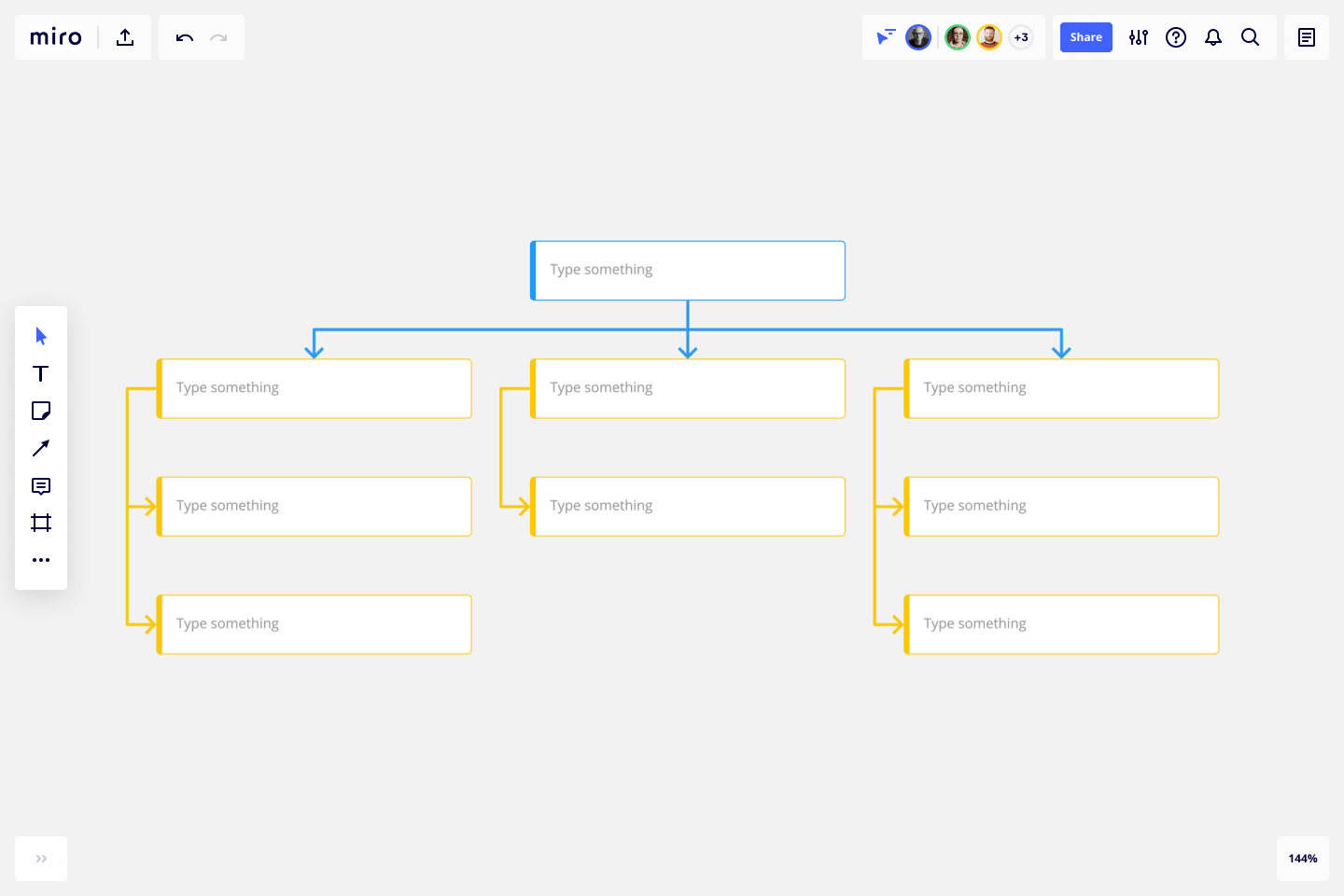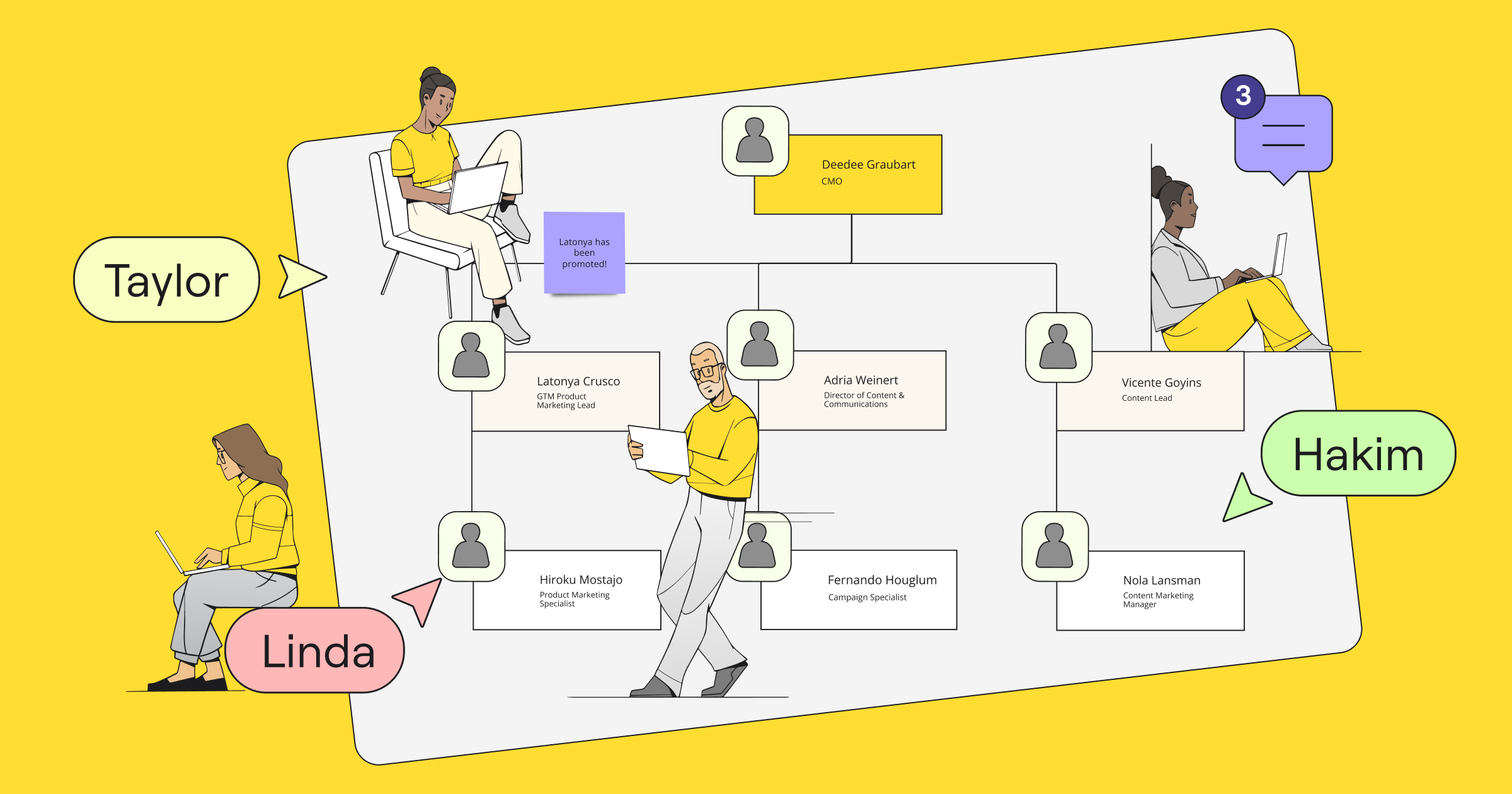A company is like a living organism. Employees come and go, teams reorganize, and workflows change.
To visualize your organizational structure as it evolves, it’s useful to have a living document like an organizational chart. Beyond tracking your employee structure at a glance, an org chart helps to train new hires, document processes, and allocate resources.
If you think org charts are all the same, think again. Below you’ll find 15 examples of creative ways to depict teams and workflows across your organization. Use these ideas and inspiration from the Miro Community to create your own.
Organizing teams
Most company org charts use a branching structure to show how teams and individual roles branch off from executive leadership to management to individual contributor roles. While a hierarchical structure is easy to understand, it isn’t the only way to visualize teams. Consider these four alternative org chart styles to bring your team structure to life.
1. Company organizational chart
This company org chart by Miro user Reid Thomas uses a tree structure (bottom to top) to illustrate Unito’s organizational structure. Notice how Thomas uses colors to indicate types of roles, connectors for reporting relationships, and boxes for each of the company divisions.
2. Organizational accountability chart
To accompany a traditional org chart, consider creating an accountability chart, which emphasizes each role’s responsibilities and outputs, rather than formal hierarchies.
3. Cross-functional team swimlane chart
If you have nonlinear processes in your organization, try a swimlane flowchart, which shows how actions transverse roles. In the diagram, each “lane” represents a different team or individual, with the flowchart crossing lanes to illustrate the flow of productivity.
4. Cross-functional flowchart
Like the swimlane chart, this cross-functional flowchart organizes teams or stakeholders into lanes and shows how a process flows across them. The template includes instructions for documenting your loops, decision points, and process steps.
Organizing processes
Like mapping reporting structures, it’s useful to map out your processes so you can streamline them and train new employees. Consider these diagrams to illustrate how processes work in your company.
1. Headcount process approval chart
Complicated hiring process? Create a chart of all of the parties involved to approve headcount and which actions they take at different stages of the process.
2. Project management flowchart
Every team has workflows for project management, but not every team has them documented. Centralize what’s tacit on paper with Sarah Moffatt’s clean and adaptable project management diagram to visualize any workflow.
3. Organizational process mapping
Stacey Fortuna’s organizational process map takes a more nuanced view by identifying process owners and labeling actions as decision tasks, manual tasks, or automated tasks.
4. Approval process chart
Unless you’re the CEO, you inevitably report up a chain of approvals. Visualize each party’s delivery and approval responsibilities with this template.
5. SIPOC process map
SIPOC stands for Supplier, Input, Process, Output, and Customer. This engaging diagramming tool lets you analyze your process from different perspectives and identify areas of improvement.
6. The writing process
Sometimes you need a process document that’s less linear and more lateral. Take this example of a writing process, which lets you document your core project information side-by-side, so you can reference the most important details at a glance.
7. Documenting the design process
While some responsibilities in a team are obvious, others may be harder to identify or define. Work with your design team to document their full process, so you can understand holistically how they function and what support they need to improve.
Organizing data and information
Understanding how data flows in and out of organizations and systems is a common challenge. Help your stakeholders grasp information flows with one of the charts below.
1. Data organizational chart
If data were people, what would your company’s data org chart look like? This chart by Elena Verna visualizes who is responsible for which data, metrics, and business outcomes.
2. Information architecture
Information architecture describes how information is organized on a website or app, and an information architecture map shows your page structure in diagram form. This template also includes boards for objective statements, user personae, and user stories to advise how your information is laid out.
3. Use case flowchart
User journeys aren’t all the same. This use case flowchart by Manar Alboqami diagrams multiple user flows for customers who may use a product in different ways.
4. Information silo chart
Having trouble working as a true cross-functional team? This silo chart helps you surface invisible barriers that may be preventing your company from doing its best work.
How to create a unique organizational chart
Org charts should be living documents, shaped by collaboration to mirror real-world structures and functions. When designed well, they offer clarity on relationships, responsibilities, and processes, helping everyone understand their place within the organization.
Since org charts can take many different forms, don’t limit yourself to static tools. Use an org chart creator that’s as dynamic as you are. Design your unique chart with shapes and connectors, collaborate with team members, and borrow ideas from our community of builders and innovators.




